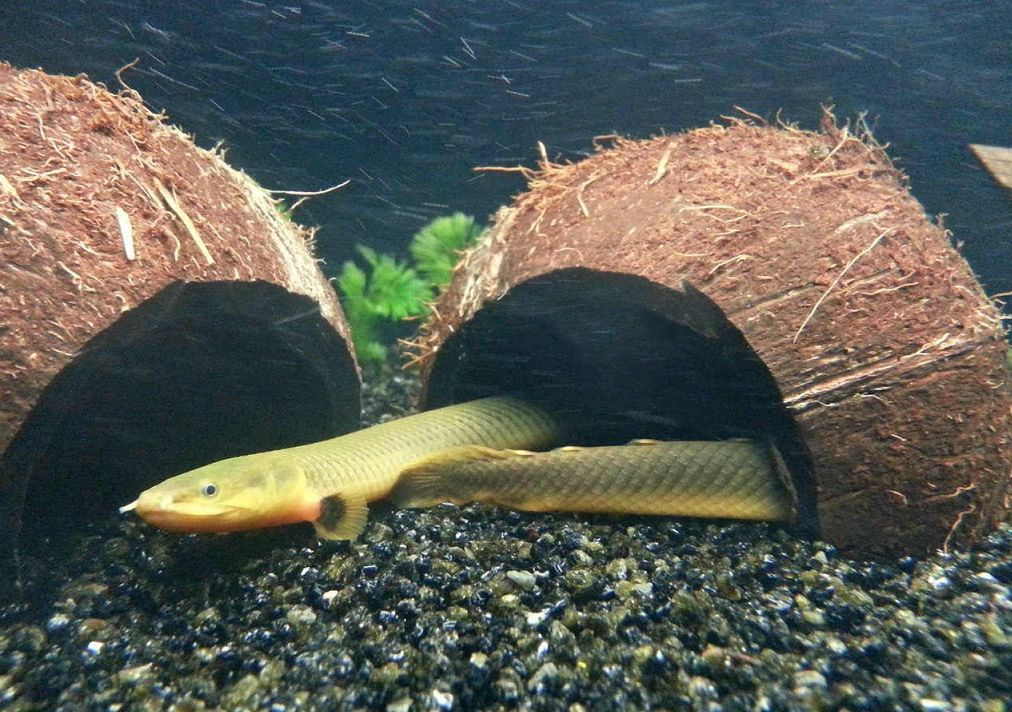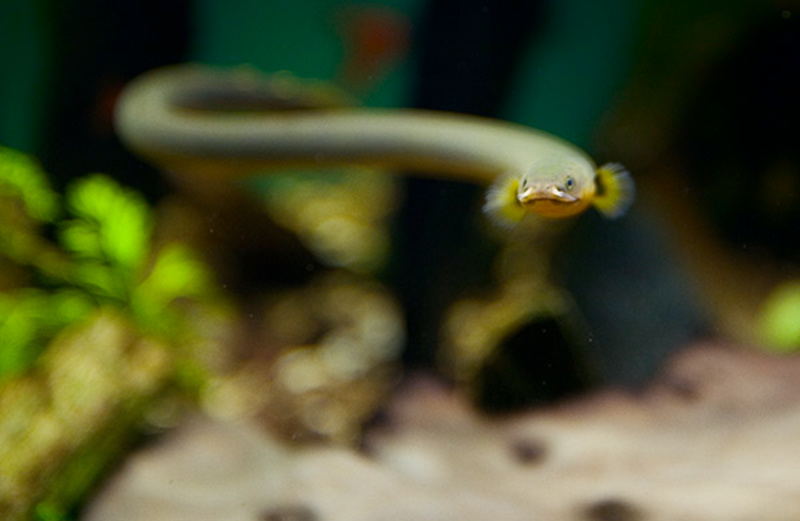Are you looking to add a unique and fascinating creature to your aquarium? Look no further than the African Ropefish! With its long, slender body and distinctive rope-like pattern, this species is sure to captivate any observer.
Native to the freshwater rivers and swamps of Africa, these fish are known for their ability to breathe air. Discover their feeding habits, breeding behaviors, and tank requirements as we delve into the world of the African Ropefish.
Physical Characteristics
You’ll notice that African ropefish have long, slender bodies and are typically dark brown or black in color. These physical characteristics are essential for their survival and behavior patterns in their natural habitat.
With their elongated bodies, ropefish can easily maneuver through dense vegetation and narrow spaces, allowing them to hide from potential predators.
Their dark coloration provides camouflage, making them blend in with the surroundings and further protecting them from detection. This is especially important because these fish have a variety of natural predators, including larger fish, birds, and other aquatic predators.
Habitat and Distribution
In their natural habitats, these unique fish can be found in slow-moving rivers and freshwater swamps. African ropefish, also known as reedfish, are primarily found in the Congo River Basin in Central Africa. They have also been reported in other parts of Africa, such as the Niger River Basin and Lake Tanganyika. These elongated fish have adapted to their environment with their snake-like appearance and ability to breathe atmospheric air. They are well camouflaged among vegetation and use their long bodies to navigate through dense aquatic plants. The table below summarizes the habitat and distribution of African ropefish:
| Habitat | Distribution |
|---|---|
| Slow-moving rivers | Congo River Basin, Niger River Basin, Lake Tanganyika |
| Freshwater swamps | Central Africa |
Ecologically, African ropefish play an important role in their ecosystems as both predator and prey. They feed on small invertebrates and fish while being food for larger predators. However, these fish face various threats due to habitat destruction, water pollution, and overfishing. Conservation efforts are being made to protect their habitats and regulate fishing practices to ensure their survival in the wild. It is crucial to recognize and address these threats to maintain the ecological balance and preserve the unique biodiversity of African ropefish habitats.
Feeding Habits
To survive, African ropefish rely on a diet of small invertebrates and other fish, making them both predator and prey in their ecosystems. Their foraging behavior is highly adapted to their preferred diet, which consists of crustaceans, worms, insects, and small fish.
- Crustaceans: African ropefish are known to feed on small crustaceans like shrimp and crayfish. They use their elongated bodies and flexible jaws to capture and consume these prey items.
- Worms: These fish have a strong preference for worms, such as earthworms and aquatic worms. They use their sharp teeth to grasp and swallow these slimy creatures.
- Insects: African ropefish have been observed hunting and feeding on various aquatic insects, including mosquito larvae, water beetles, and dragonfly nymphs. They exhibit patience and precision while catching these fast-moving prey.
- Small Fish: Although African ropefish primarily feed on invertebrates, they’ve been known to consume small fish when the opportunity arises. They use their stealth and ambush tactics to capture unsuspecting prey fish.
Overall, the foraging behavior of African ropefish demonstrates their versatility and adaptability as both predators and prey in their ecosystems. Their preferred diet ensures they obtain the necessary nutrients for survival in their natural habitats.
Breeding and Reproduction
When breeding, you’ll notice that African ropefish exhibit complex courtship behaviors, such as chasing, nipping, and displaying their vibrant colors to attract a mate.
Breeding techniques for these fish involve creating optimal conditions within the aquarium. To stimulate reproduction, maintain a temperature of around 78 to 82 degrees Fahrenheit and provide hiding spots with plants or caves.
Ropefish are oviparous, meaning they lay eggs, and the male fertilizes them externally. Once the female lays the eggs, the male will guard and fan them to ensure adequate oxygen supply.
The eggs typically hatch within a week, and the fry are initially transparent and very small. Offering live or frozen foods, such as brine shrimp or daphnia, will help nourish the young ropefish as they grow.
Understanding the reproductive behavior and implementing suitable breeding techniques will increase the chances of successful reproduction in African ropefish.

Care and Tank Requirements
Ensure your tank is large enough to accommodate the size and activity level of these fish. African ropefish require a tank with a minimum capacity of 50 gallons.
Here are some important considerations for their tank setup:
- Water temperature: Maintain a temperature range of 73-82°F (23-28°C) to replicate their natural habitat.
- Water pH level: Keep the pH level between 6.5-7.5 to provide optimal conditions for the ropefish.
- Filtration: Use a powerful filtration system to maintain water quality and ensure proper oxygenation.
- Tank decoration: Provide hiding places using rocks, driftwood, and vegetation. Dense planting along the sides will help create a sense of security.
It is crucial to regularly monitor the water parameters and perform regular water changes to maintain a healthy environment for your African ropefish.
Following these guidelines will help create an ideal tank setup for these fascinating fish.
Conclusion
In conclusion, the African ropefish is a fascinating species with unique physical characteristics, such as its elongated body and rope-like appearance. It’s primarily found in freshwater habitats across Africa and is known for its ability to adapt to various environments.
Its feeding habits primarily consist of small invertebrates and fish. Breeding and reproduction occur through the laying of eggs, followed by parental care.
Proper care and tank requirements are crucial to ensure the well-being and longevity of these captivating creatures.

